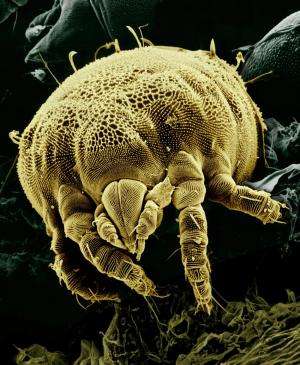Mite sets new record as world's fastest land animal

Move over, Australian tiger beetle. There's a new runner in town.
Although the mite Paratarsotomus macropalpis is no bigger than a sesame seed, it was recently recorded running at up to 322 body lengths per second, a measure of speed that reflects how quickly an animal moves relative to its body size. The previous record-holder, the Australian tiger beetle, tops out at 171 body lengths per second. By comparison, a cheetah running at 60 miles per hour attains only about 16 body lengths per second.
Extrapolated to the size of a human, the mite's speed is equivalent to a person running roughly 1300 miles per hour.
The California college student who spent a summer chasing down the remarkable mites says the discovery is exciting not only because it sets a new world record, but also for what it reveals about the physiology of movement and the physical limitations of living structures.
"It's so cool to discover something that's faster than anything else, and just to imagine, as a human, going that fast compared to your body length is really amazing," said Samuel Rubin, a junior and physics major at Pitzer College who led much of the fieldwork to document the mite's movements. "But beyond that, looking deeper into the physics of how they accomplish these speeds could help inspire revolutionary new designs for things like robots or biomimetic devices."
Rubin's advisor, Jonathan Wright, Ph.D., a professor of biology at Pomona College, became interested in the mites while studying the effect of muscle biochemistry on how quickly animals can move their legs. But it wasn't until Rubin and other students documented the mites' running speeds in their natural environment that the research team knew they had found a new world record.
Both relative speed and stride frequency increase as animals get smaller, and in theory, muscle physiology should at some point limit how fast a leg can move. "We were looking at the overarching question of whether there is an upper limit to the relative speed or stride frequency that can be achieved," said Wright. "When the values for mites are compared with data from other animals, they indicate that, if there is an upper limit, we haven't found it yet."
The mite is local to Southern California and is often found running along rocks or sidewalks. Although it was first identified in 1916, little is known about its habits or food sources.
The research team used high-speed cameras to record the mites' sprints in the laboratory and in their natural environment. "It was actually quite difficult to catch them, and when we were filming outside, you had to follow them incredibly quickly as the camera's field of view is only about 10 centimeters across," said Rubin.
The research team was also surprised to find the mites running on concrete up to 140 degrees Fahrenheit (60 degrees Celsius), a temperature significantly higher than the upper lethal temperature of most animals. "They're operating at temperatures that seem to preclude activities of any other animal group. We've seen them running where there were no other animals visibly active," said Wright.
The mites also are adept at stopping and changing directions extremely quickly, attributes the researchers are investigating further for potential insights that may be relevant to bioengineering applications.

















